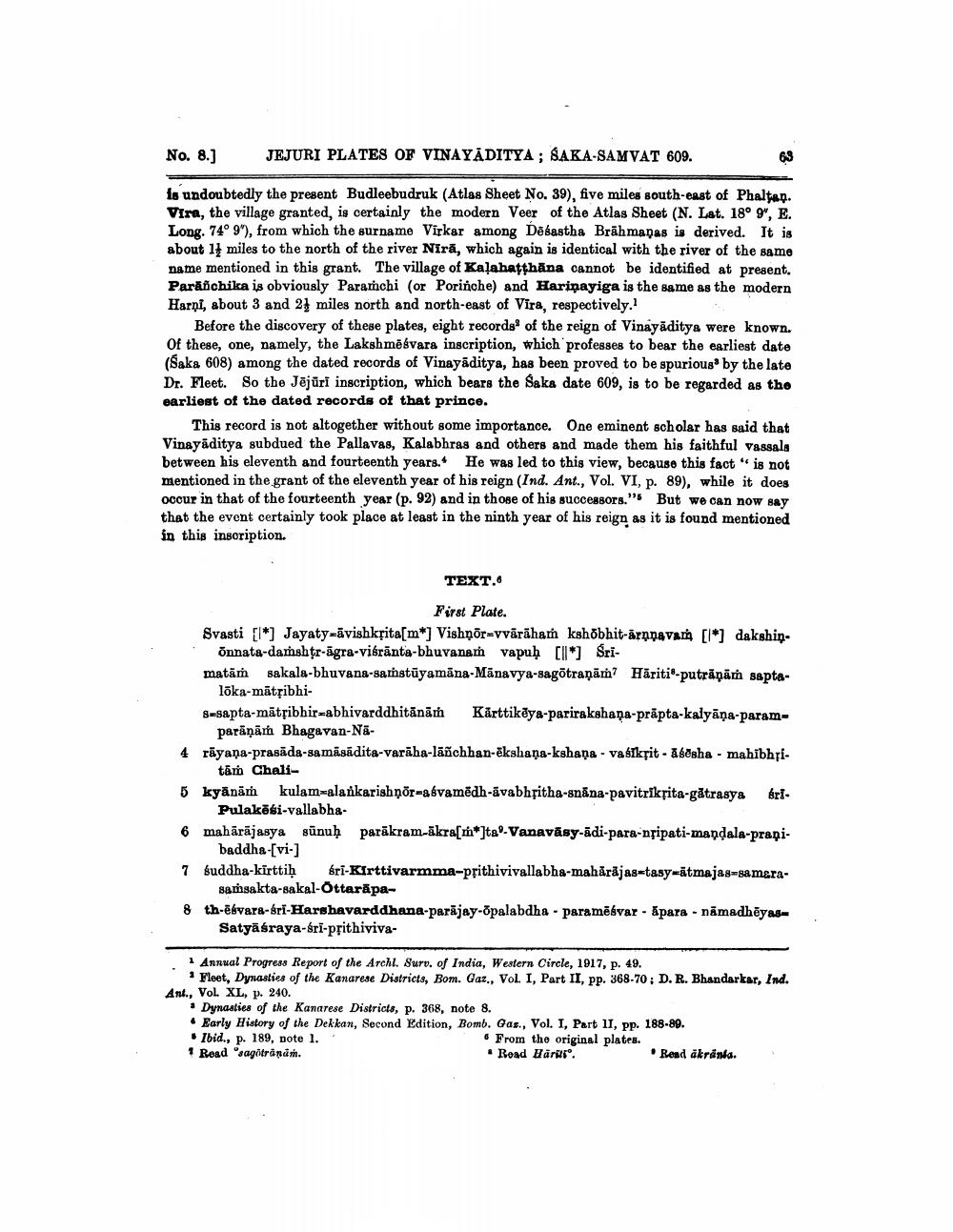________________
No. 8.]
JEJURI PLATES OF VINAYADITYA; SAKA-SAMVAT 609.
is undoubtedly the present Budleebudruk (Atlas Sheet No. 39), five miles south-east of Phaltan. Vira, the village granted, is certainly the modern Veer of the Atlas Sheet (N. Lat. 18° 9", E. Long. 74° 9"), from which the surname Virkar among Desastha Brahmanas is derived. It is about 1 miles to the north of the river Nira, which again is identical with the river of the same name mentioned in this grant. The village of Kalahaṭṭhāna cannot be identified at present. Parañchika is obviously Paramchi (or Porinche) and Haripayiga is the same as the modern Harni, about 3 and 24 miles north and north-east of Vira, respectively.1
Before the discovery of these plates, eight records of the reign of Vinayaditya were known. Of these, one, namely, the Lakshmesvara inscription, which professes to bear the earliest date (Saka 608) among the dated records of Vinayaditya, has been proved to be spurious by the late Dr. Fleet. So the Jejuri inscription, which bears the Saka date 609, is to be regarded as the
earliest of the dated records of that prince.
This record is not altogether without some importance. One eminent scholar has said that Vinayaditya subdued the Pallavas, Kalabhras and others and made them his faithful vassals between his eleventh and fourteenth years. He was led to this view, because this fact" is not mentioned in the grant of the eleventh year of his reign (Ind. Ant., Vol. VI, p. 89), while it does occur in that of the fourteenth year (p. 92) and in those of his successors." But we can now say that the event certainly took place at least in the ninth year of his reign as it is found mentioned in this inscription.
First Plate.
Svasti [*] Jayaty-avishkṛita[m*] Vishnōr-vväräham kshōbhit-arnnavam [*] dakshinōnnata-damshṭr-agra-viśranta-bhuvanam vapuḥ [*] Sri
matām sakala-bhuvana-samstuyamana-Manavya-sagōtraṇām? Hariti-puträņām saptalōka-mātṛibhi
s-sapta-matribhir-abhivarddhitānāṁ
parānam Bhagavan-Na
TEXT.6
Kärttikeya-parirakshana-präpta-kalyāṇa-param
4 rayana-prasada-samāsādita-varaha-lañchhan-ekshana-kshana vaśīkṛit - Aéesha - mahibhri
tām Chali
5 kyānāṁ kulam-alankarishpor-aévamedh-avabhritha-snana-pavitrîkrita-gātrasya śrī
Pulakesi-vallabha
63
6 mahārājasya sūnuḥ parakram-akra[m*]ta-Vanavasy-adi-para-nṛipati-mandala-pranibaddha-[vi-]
7 suddha-kirttiḥ
śri-Kirttivarmma-prithivivallabha-mahārājas-tasy-atmajas-samara
8 th-eévara-sri-Harshavarddhana-parajay-õpalabdha parameévar apara namadheyas
samsakta-sakal-Ottarapa
Satyasraya-śrī-prithiviva
1 Annual Progress Report of the Archl. Surv. of India, Western Circle, 1917, p. 49.
Fleet, Dynasties of the Kanarese Districts, Bom. Gaz., Vol. I, Part II, pp. 368-70; D. R. Bhandarkar, Ind. Ant., Vol. XL, p. 240.
Dynasties of the Kanarese Districts, p. 368, note 8.
Early History of the Dekkan, Second Edition, Bomb. Gaz., Vol. I, Part II, pp. 188-89.
Ibid., p. 189, note 1.
From the original plates. Read Hariti.
1 Read "sagitrāṇāṁ.
Read äkränta.




